
Mathematics, 06.05.2020 02:24 gatorlove00
If the animal is in the woods on one observation, then it is twice as likely to be in the woods as the meadows on the next observation. If the animal is in the meadows on one observation, then it is four times as likely to be in the meadows as the woods on the next observation. Assume that state 1 is being in the meadows and that state 2 is being in the woods.(1) Find the transition matrix for this Markov process.(2) If the animal is initially in the woods, what is the probability that it is in the woods on the next three observations?(3) If the animal is initially in the woods, what is the probability that it is in the meadow on the next three observations?

Answers: 1


Another question on Mathematics

Mathematics, 21.06.2019 15:00
Given the choice between receiving $1.000.000 in one month or a single penny-doubled everyday for the period of one month; which option would you choice? show your work to support your answer. (assume that 1 month=30 days)
Answers: 1

Mathematics, 21.06.2019 17:00
What properties allow transformation to be used as a problem solving tool
Answers: 1

Mathematics, 21.06.2019 20:30
Find the value of x. give reasons to justify your solutions! h ∈ ig
Answers: 1

Mathematics, 21.06.2019 21:40
Asystem of linear equations contains two equations with the same slope. select all of the correct statements. i a. the system may have two solutions. - b. the system may have infinitely many solutions. c. the system may have one solution. o d. the system may have no solution. submit
Answers: 3
You know the right answer?
If the animal is in the woods on one observation, then it is twice as likely to be in the woods as t...
Questions


Physics, 12.05.2020 09:57

Chemistry, 12.05.2020 09:57

Mathematics, 12.05.2020 09:57

Chemistry, 12.05.2020 09:57

Mathematics, 12.05.2020 09:57



Mathematics, 12.05.2020 09:57


Mathematics, 12.05.2020 09:57

Mathematics, 12.05.2020 09:57


Business, 12.05.2020 09:57




English, 12.05.2020 09:57


History, 12.05.2020 09:57

![M = \left[\begin{array}{ccc}2/3 &1/4 \\1/3 &3/4}\end{array}\right]](/tpl/images/0645/2268/397c7.png)

 be transition between the states, i = 1,2; j = 1,2
be transition between the states, i = 1,2; j = 1,2![M = \left[\begin{array}{ccc}T_{11} &T_{12} \\T_{21} &T_{22}\end{array}\right]](/tpl/images/0645/2268/4361d.png)

![M^{3} = \left[\begin{array}{ccc}2/3 &1/4 \\1/3 &3/4}\end{array}\right]\left[\begin{array}{ccc}2/3 &1/4 \\1/3 &3/4}\end{array}\right]\left[\begin{array}{ccc}2/3 &1/4 \\1/3 &3/4}\end{array}\right]](/tpl/images/0645/2268/c1378.png)
![M^{3} = \left[\begin{array}{ccc}203/432 &229/576 \\229/432 &347/576}\end{array}\right]](/tpl/images/0645/2268/de02f.png)
 = 347/576
= 347/576 = 229/576
= 229/576


